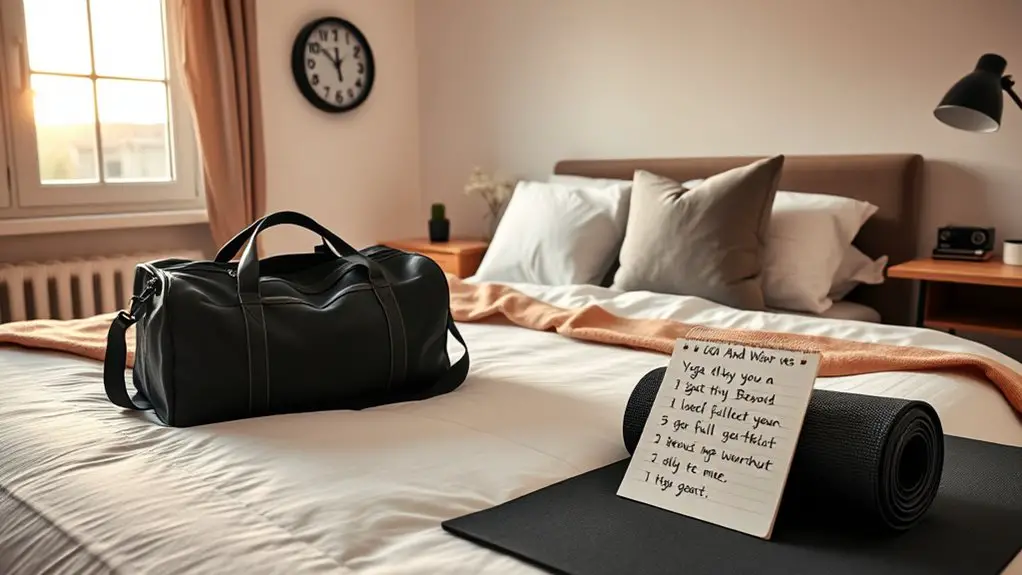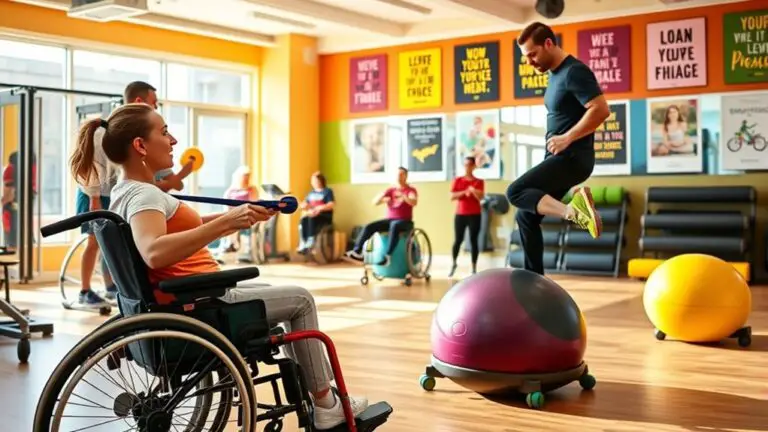How to Make Time for Gym Training Without Sacrificing Sleep

To make time for gym training without sacrificing sleep, assess your daily schedule and identify pockets for workouts. Prioritize specific fitness goals and opt for short, high-intensity sessions to maximize efficiency. Incorporate exercise into daily activities, like walking meetings or biking to work, and utilize your commute for added cardio. Create a consistent sleep routine, and set realistic expectations to stay flexible. Keep going, and you’ll discover more effective strategies that fit your lifestyle.
Assess Your Current Schedule

To find time for gym training, the first step is evaluating your current schedule. Look at how you spend each day and identify pockets of time that could be dedicated to working out. This process is vital for effective time management. Start by jotting down your daily activities—work, meals, family time, and relaxation.
Once you’ve mapped it out, assess where you can make adjustments. Are there activities you can cut back on or combine? Maybe you can switch your evening TV time for a quick gym session, or utilize your lunch break for a workout. By conducting a thorough schedule evaluation, you’ll uncover opportunities for training without sacrificing your essential commitments. Many gyms also offer orientation or classes for newcomers to help you get started on the right foot.
Prioritize Your Fitness Goals
While balancing your schedule, it’s crucial to prioritize your fitness goals to guarantee that gym training becomes a consistent part of your routine. Effective goal setting not only provides direction but also fuels your motivation. Here are three techniques to help you stay focused:
- Set Specific Goals: Instead of vague intentions like “get fit,” aim for measurable targets like “attend the gym three times a week.”
- Create a Vision Board: Visualizing your goals can be a powerful motivation technique. Include images and quotes that inspire you to stay committed.
- Track Your Progress: Regularly monitor your achievements. Celebrating small wins reinforces your dedication and keeps you energized for the journey ahead. Additionally, acknowledging the need for rest days can help prevent burnout and maintain your overall motivation.
Opt for Short, High-Intensity Workouts

When you’re pressed for time but still want to make gym training a priority, opting for short, high-intensity workouts can be a game changer. High-Intensity Interval Training (HIIT) packs a powerful punch in a fraction of the time compared to traditional workouts. With HIIT benefits like increased metabolism and improved cardiovascular health, you can achieve more in just 20 to 30 minutes. Incorporating exercises like jump rope can further enhance your cardio fitness during these compact sessions.
Utilize Your Commute Time
Maximizing your workout efficiency isn’t just about what you do in the gym; it can also extend to your daily routine. By utilizing your commute time, you can seamlessly incorporate fitness into your day. Here are a few ideas for effective commute workouts:
- Walk or Bike: If your workplace is nearby, consider walking or biking instead of driving. It’s a great way to fit in some cardio.
- Public Transport: If you take public transport, get off a stop early and walk the rest of the way. This adds extra steps to your day.
- Bodyweight Exercises: While waiting for your bus or train, do some quick bodyweight exercises like squats or lunges to keep your muscles engaged.
Incorporating these activities can help you achieve a full-body workout that supports your fitness goals. Active commuting not only helps you stay fit but also boosts your energy levels, making it easier to tackle your day. So, make the most of your commute!
Incorporate Exercise Into Daily Activities

Finding ways to fit exercise into your daily activities can transform mundane routines into opportunities for staying active. One simple strategy is to schedule walking meetings instead of sitting in a conference room. This not only gets your blood pumping but also sparks creativity. You can also consider incorporating active hobbies into your weekends or evenings. Whether it’s dancing, hiking, or gardening, these activities keep you moving while having fun.
Additionally, try taking the stairs instead of the elevator, or park further away from your destination. Small adjustments like these can add up over time. Think about your daily tasks and identify moments where you can move more, even if it’s just a quick stretch or a few lunges. By making these changes, you’ll seamlessly integrate exercise into your life without sacrificing too much time or energy. Embrace the idea that every bit of movement counts! Plyometric training can also enhance your overall fitness through explosive movements that can be integrated into your routine.
Create a Consistent Sleep Routine
Creating a consistent sleep routine is essential for enhancing your energy levels and overall well-being, especially if you’re aiming to make time for gym training. Prioritizing sleep hygiene can greatly impact your daily performance and workout effectiveness. To establish a solid sleep routine, try these simple steps:
Establishing a consistent sleep routine is vital for boosting energy and enhancing gym performance. Prioritize sleep hygiene for optimal results.
- Set a Regular Bedtime: Go to bed and wake up at the same time daily, even on weekends, to regulate your body clock.
- Create Bedtime Rituals: Engage in calming activities like reading or meditating before sleep to signal your body it’s time to wind down.
- Limit Screen Time: Reduce exposure to screens at least an hour before bed to help your mind relax and prepare for sleep.
Set Realistic Expectations and Be Flexible

While it’s great to have fitness goals, setting realistic expectations is essential for maintaining motivation and avoiding burnout. You want to be ambitious, but if you aim too high, you might feel overwhelmed. Start by breaking your goals into manageable chunks. Instead of saying, “I’ll work out every day,” try, “I’ll exercise three times a week.” This approach makes time management easier and keeps your motivation high.
Additionally, be flexible. Life can be unpredictable, and that’s okay! If you miss a workout, don’t dwell on it. Adjust your schedule and move on. Remember, goal setting isn’t just about the end result; it’s about the journey. Celebrate small victories along the way to stay inspired. By setting achievable goals and adapting as needed, you’ll find that making time for the gym becomes a rewarding part of your routine, without sacrificing your much-needed sleep. Regular exercise reduces the risk of chronic diseases such as heart disease and diabetes, adding to the importance of maintaining your fitness journey.
Frequently Asked Questions
How Can I Stay Motivated to Train Regularly?
Staying motivated to train regularly starts with goal setting. Break your goals into manageable steps and share them with accountability partners. Their support can keep you focused, making workouts enjoyable and ensuring you stick to your routine.
What Are the Best Pre-Workout Snacks for Energy?
For energy boosting foods, consider quick snack options like bananas, Greek yogurt, or a handful of nuts. These will fuel your workout, keeping you energized and engaged. You’ll feel ready to tackle any training session!
Is It Okay to Skip Workouts Occasionally?
It’s okay to skip workouts occasionally; life happens. Prioritizing workout balance helps you maintain consistency, while adjusting your training priorities allows you to recharge. Remember, rest can enhance your overall performance and motivation.
How Do I Recover From Fatigue After Training?
To recover from fatigue, focus on effective fatigue management. Incorporate recovery techniques like proper hydration, balanced nutrition, and quality sleep. Listen to your body, and don’t hesitate to rest when needed for peak performance.
What Should I Do if I Can’t Sleep After Exercising?
If you’re tossing and turning after exercising, don’t sweat it. Focus on post exercise relaxation techniques like calming bedtime routines. Try reading or meditating to help your mind unwind and ease into restful sleep.





